by Ian Skellern
Welcome to the 2016 edition of Quill & Pad’s early Grand Prix d’Horlogerie de Genève predictions in which the team picks favorites and explains why. Please enjoy the opinions of the following panelists:
Ian Skellern (IS), co-founder and technical director
Joshua Munchow (JM), resident nerd writer
GaryG (GG), resident collector
Martin Green (MG), resident gentleman
Alex Ghotbi (AG), watch expert at Phillips and contributor
Ryan Schmidt (RS), author of The Wristwatch Handbook: A Comprehensive Guide to Mechanical Wristwatches and contributor
As a jury member, editor-in-chief Elizabeth Doerr is excluded from these early predictions.
The Tourbillon category is defined by the GPHG as for, “mechanical watches comprising at least one tourbillon. Additional indications and/or complications are admissible.”

Pre-selected Tourbillon category watches in the 2016 edition of the Grand Prix d’Horlogerie de Genève
GG: Now we’re talking! After I ho-hummed my way through the Chronograph category, I got charged up again looking at these six delightful pieces.
JM: The Tourbillon category is a rather difficult one to decide on, mainly due to the fact that the styling is so different between the competing watches, with more focus on mechanical ingenuity while others have promoted the overall presentation. Each watch in this category has a reason to be pre-selected, and I’m hesitant to choose who might win. Alas, that is our job, so I’ll just have to make the tough decisions and make someone very happy.
AG: I like tourbillons, I appreciate the craftsmanship and innovation that goes into them, but once again other than the De Bethune Kind of Blue DB28 Tourbillon and Girard-Perregaux La Esmeralda Tourbillon I really can’t get excited by the other runner-ups.
RS: At first glance, the pre-selected list seems a little tame compared to last year, Alex, but on closer inspection there really are some great watches here and a few of them are doing more than just throwing a tourbillon at you.
The sight of a rotating regulating organ on the dial of the watch does not necessarily draw the shortness of breath that it once did, and I have noticed more than a passing bout of “tourbillon apathy” amongst the seasoned watch enthusiast community.
I do wonder if the GPHG would do better to call this the “Complicated Regulator” category – but then again that does sound a little boring! So which of the watches here are just flashing their springs at us and which have more to offer?
De Bethune DB28 Kind of Blue Tourbillon
IS: I’ll admit up front that I’m a De Bethune fan boy and the proud and extremely fortunate owner of a DB28. So I’m biased.
One of the (many) things I like about the brand is that it does not treat components with synthetic coloring. The incredibly vibrant blue of the Kind of Blue DB28 Tourbillon derives solely from heat treatment, similar to the process to make heat-blued steel hands. What is very difficult with this method is ensuring that different metals of different shapes and sizes all have a fairly homogeneous blue hue.
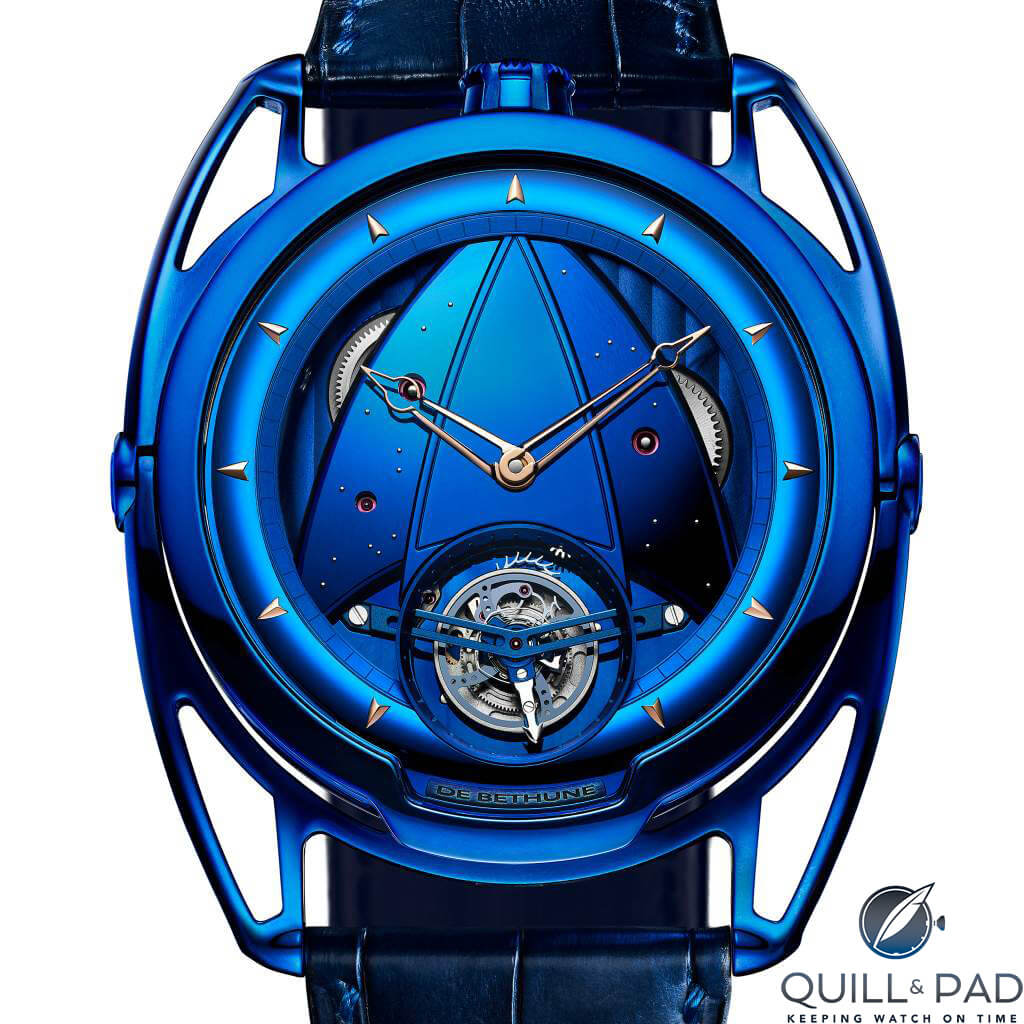
De Bethune DB28T Kind of Blue Tourbillon
RS: Indeed, Ian, there is nothing quite like grade 5 blued titanium, and nobody blues titanium like De Bethune. For a few years now I have delighted at the sight of this rich accent on earlier models, whether it be deployed on the chapter ring, dial, bridges or case. But here it’s all of the above! This magnificent mass of deliciously blued titanium provides the foundations and the architecture for a fantastic tourbillon.
JM: It should come as no surprise that I absolutely love De Bethune and, by extension, most of the things that this brand does. The DB28 has always been a favorite of mine, as well as the incredible blued titanium that De Bethune is so famous for. The DB28T Kind Of Blue Tourbillon checks a lot of my boxes for a De Bethune, and the extreme bluing throughout the watch creates such a mesmerizing effect that I have to include it in my top three. It glows like the cosmos and it definitely deserves recognition as arguably the most beautiful watch in this category!
IS: I like the fast 30-second tourbillon rotation coupled with the long 120-hour power reserve, the silicon balance wheel, and De Bethune’s floating lugs make for the most comfortable-wearing watches. Ever.
That said, I do think that to be a serious contender in this category a brand needs to present a more original new watch; the tourbillon base caliber of the Kind of Blue just isn’t new enough in this respect.
RS: With its silicon balance wheel, white gold rim, and their take on the Breguet overcoil, the mechanism is claimed to be the lightest in the world, and it might just be among the coolest too. On looks alone this wins, for technical merit it might just win too. It’s the watch I would run off with if I had the keys to the display cabinet, but if the jury is looking at this objectively and with a focus on the tourbillon, the DB28T comes a very close second to the Rudis Sylva in my opinion.
AG: I love De Bethune, these guys are creating twenty-first century watchmaking! And in 100 years’ time this brand will (hopefully) be looked upon as a Breguet or Berthoud of its time. De Bethune just doesn’t cut corners or make marketing watches.
The Kind of Blue with fully blued titanium case and movement is striking and visually arresting. The tourbillon weights 0.20 gram, just the thought of it is mind boggling! Kudos to DB.
MG: Is this watch even made by humans? It seems like it comes from outer space, not only in terms of design, but also in a technical sense. You always think that De Bethune has reached the boundaries in terms of design and technical capabilities, and they just love to prove you wrong!
This watch tantalizes the senses in a hyper-car kind of way, blowing every other tourbillon out of the water, and that says a lot in this heavily contested category.
GG: The De Bethune Kind of Blue was MrsGaryG’s favorite watch of those she saw at the 2016 SIHH, so please don’t tell her that I didn’t select it! The mixture of blue textures and tones is stunning, and this watch is perhaps the one among this category’s finalists I’d most like to wear, but against tough competition it suffers a bit for being a visual variant of the tried-and-true DB28.
For more information, please visit www.gphg.org/horlogerie/en/watches/db28-kind-blue-tourbillon.
Quick Facts De Bethune DB28T Kind of Blue Tourbillon
Case: 42.6 x 9.2 mm, blued grade 5 titanium
Movement: manually wound Caliber DB2115 with one-minute tourbillon
Functions: hours, minutes; power reserve indication
Price: 250,000 Swiss francs
Rudis Sylva RS 16 Harmonious Oscillator
GG: I similarly and regretfully nudged the Rudis Sylva down my list for the same reason as the De Bethune, as this very pretty Eric Giroud-styled piece is based directly on the 2009 Harmonic Oscillator from Rudis Sylva.
RS: You’re right, Gary: the harmonious oscillator is extremely interesting, but it’s not the first time this technology has been presented to the GPHG. Back in 2009, the RS05-01 was submitted amongst 43 other watches in the Complicated category. Between the A. Lange & Söhne Lange 31, the Concord C1, the deGrisogono Meccanico, the TAG Heuer Monaco V4 Tourbillon, and the ultimate winner, the Greubel Forsey Double Tourbillon 30° Technique, it’s understandable that such a technical alternative to the tourbillon might be overlooked.
But for 2016 we have the Tourbillon category, and although one can quite easily argue that the harmonious oscillator is not a tourbillon, it does belong here and it is a corker. It justifiably brings to mind the Haldimann H2 Flying Resonance and the F.P. Journe Chronomètre à Resonance, and yet at first glance it looks less wild than either of those.
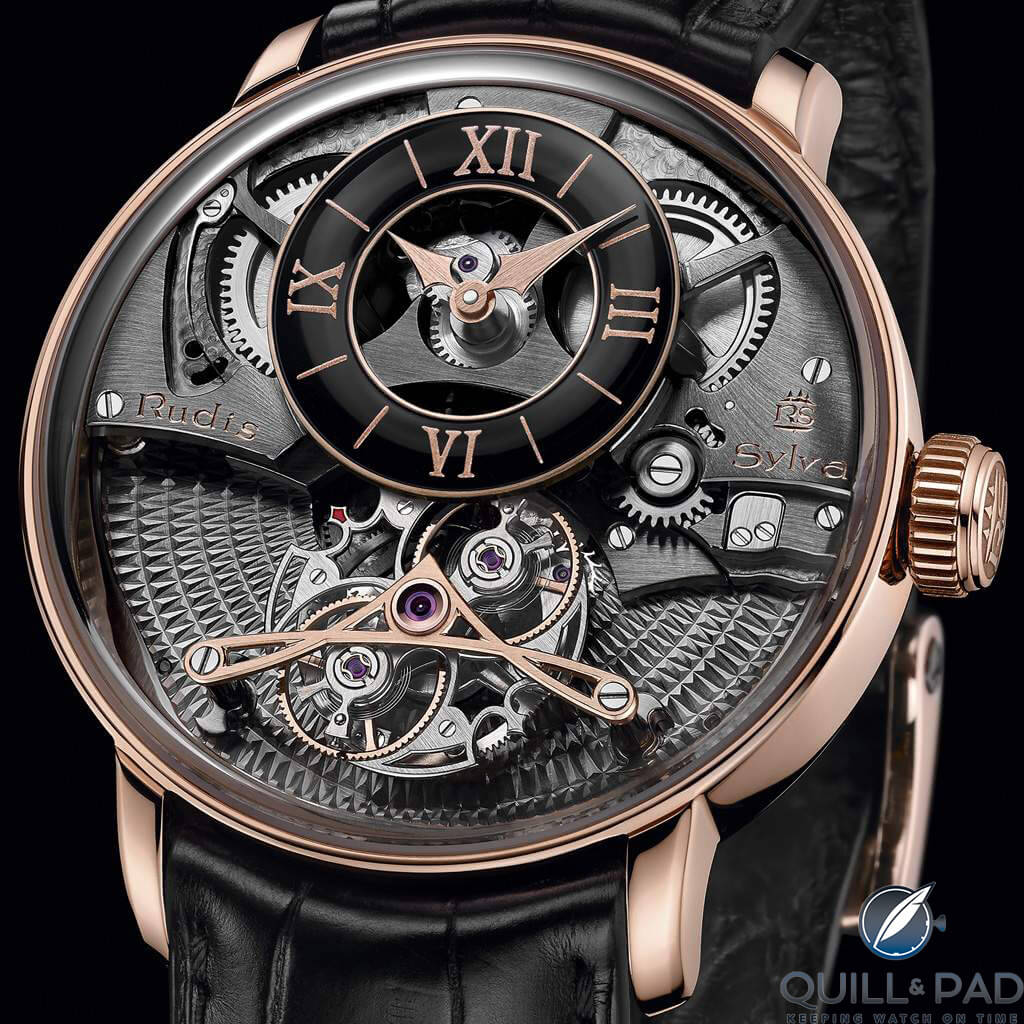
Rudis Sylva RS 16 Harmonious Oscillator
IS: Watchmakers and watch designers tend to be conservative, which is one of – if not THE – reason that so many watches are virtually indistinguishable from each other bar the name on the dial.
With its open dial and rotating double tourbillons, not only is the Rudis Sylva RS 16 Harmonious Oscillator very distinctive visually, but the way that the two tourbillons are coupled is quite technically distinctive as well.
Before the Harmonious Oscillator, double (MB&F Legacy Machine No. 2), triple (Antoine Preziuso Tourbillon Of Tourbillons), and even quadruple regulators (Greubel Forsey Quadruple Tourbillon) have been coupled using differentials that display time as the average of the rates of the individual regulators.
While a miniature differential allows multiple regulators to run at their natural rates, it is a complex mechanism that will introduce its own set of errors as well as friction. With the Harmonious Oscillator, Rudis Sylva has dispensed with the differential entirely and coupled the two tourbillon regulators by directly meshing the balance wheels of each oscillator. The balance wheels have interlocking teeth that force the two regulators to run at their average rate.
This tenth anniversary edition of the Harmonious Oscillator is an eye-catcher, and I’m a fan of the brand, but . . . to be a player in this category I think we need more than a revamped version of an existing movement, no matter how nicely executed it is. The RS 16 Harmonious Oscillator is a great watch, but it isn’t new enough for me to win this category.
RS: But it is wild and I am genuinely fascinated by this mechanism. Like the Haldimann H2 Flying Resonance, it features a set of two coupled balance wheels that rotate around a shared axis. The RS16, however, uses just one escapement and the two balance wheels are coupled by meshed teeth on their rims. Observing the mechanism in a static position, it’s almost jarring to see these two wheels locked together like that.
The F.P. Journe Chronomètre à Resonance places them incredibly close, but they are physically uncoupled – and thus resonant – while the H2 uses two escapements and couples the balance wheels by a bar that runs from one hairspring stud to the other. The escape wheel of the harmonious oscillator delivers an impulse to one balance wheel, which distributes it to the other wheel via their coupled teeth. Neither can oscillate without the other, and as a consequence you have two oscillators immediately distributing an error that a tourbillon requires one minute of rotation to do.
Rudis Sylva has made claims of superior accuracy and puts the harmonious oscillator at the top of the pile of gravity-combating devices. I would argue that the tilted tourbillons of Greubel Forsey, multi-axis tourbillons such as those of Thomas Prescher, and Zenith’s “Zero Gravity Control” module may well trump the harmonious oscillator by offering solutions to the Achilles heel of the wristwatch tourbillon – the horizontal position – but as I see none of those devices in the running this year, Rudis Sylva shouldn’t lose any sleep over it.
MG: This is a technical masterpiece of great importance! With the Harmonious Oscillator Rudis Sylva has not only taken the next step into defying gravity, but with the help of Eric Giroud, also offers it in a breathtaking packaging. The result is a classical masterpiece that shows off the finest engraving, guilloche, and grand feu enamel craftsmanship in the business, on top of that exciting complicated movement.
JM: Like I stated before, this category was a hard battle due to the amazing variety of watches. That’s why I have a tie for my first runner-up that includes this model.
The two balance wheels are toothed on the RS 16, meaning that they oscillate while mechanically linked, leading to an averaged period for more consistent timekeeping. The two oscillators further rotate as they are mounted in a single tourbillon carriage, providing that extra compensation to average the effects of gravity in certain positions.
For more information, please visit www.gphg.org/horlogerie/en/watches/rs-16-harmonious-oscillator.
Quick Facts Rudis Sylva RS 16 Harmonious Oscillator
Case: 44 x 14.3 mm, pink gold
Movement: manually wound Caliber RS16 with one-minute tourbillon comprising double balances linked by meshing teeth on balance wheels; 70-hour power reserve
Functions: hours, minutes, seconds
Price: 250,000 Swiss francs
Louis Moinet Sideralis Evo
JM: My other choice as first runner-up is the Louis Moinet Sideralis Evo, an incredible double tourbillon presented in a skeletonized format with a rather awesome and unique complication tied to it. The two tourbillons rotate in opposite directions, and this motion allows for a display behind the minute and hour hands on the dial to dazzle the wearer with three heavenly bodies (the moon, Mars, and Mercury) moving around the miniature painted sky.
Two disks rotate in opposite directions with a window cut into the top disk that shows the three bodies move past underneath. The display really is a sight to behold. The style is also familiar to the Rudis Sylva with highly engraved plates and stylized bridges. Even though they look very different, they satisfy some of the same technical and aesthetic desires!
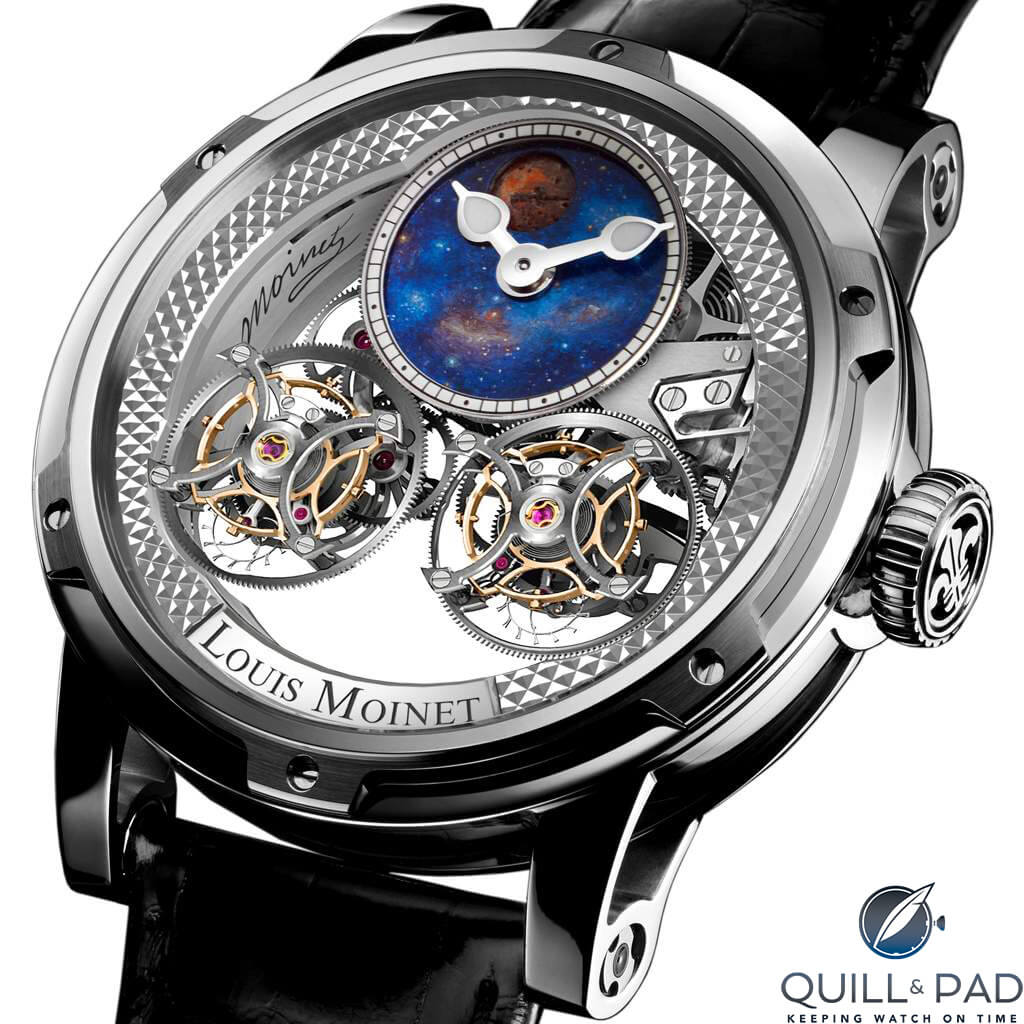
Louis Moinet Sideralis Evo
IS: If only Louis Moinet would put as much effort into explaining their watches as they do in developing them, I’m sure they would be appreciated much more. The Sideralis Evo is a breathtakingly beautiful watch and it looks to be as impressive technically, but the explanation is nearly incomprehensible to me.
Firstly, let’s look at the claim that the Sideralis Evo is “the first and only double tourbillon whose function is to power a watch complication – the first patent application of its kind.” I’m sure that other double tourbillons have powered a complication, even if the complication was a power reserve indicator, but while “powering a complication” probably wasn’t the purpose of the other tourbillons, it makes Louis Moinet’s claim sound a bit like splitting hairs if not downright clutching at straws.
Are the two tourbillons of the Sideralis Evo not connected with one regulating the timekeeping while the other regulates/powers the “sideralis” display? I don’t think so, but that might be interesting. However the tourbillons are connected I don’t see any technical benefit . . . which doesn’t mean that there isn’t a benefit, or even that that’s the point.
And then there is the sidereal display itself. Sidereal is defined as, “of or with respect to the distant stars (i.e., constellations or fixed stars, not the sun or planets).” Basically, sidereal time takes its reference from one or multiple distant stars rather than our familiar close neighbor, the sun.
However, the sidereal display on the Sideralis Evo successively shows planets and a moon − Mars, our moon, and Mercury − and planets and moons have nothing at all to do with sidereal time. What Louis Moinet refers to as a sidereal complication appears to be simply a disk with planets rotating past a stationary starry sky.
But that said – and I may have misunderstood the complication because I just cannot make sense of the press text – I think that the Sideralis Evo is a beautiful tourbillon and whatever it is it does, it looks to do that well. The Sideralis Evo is my runner-up in the tourbillon category.
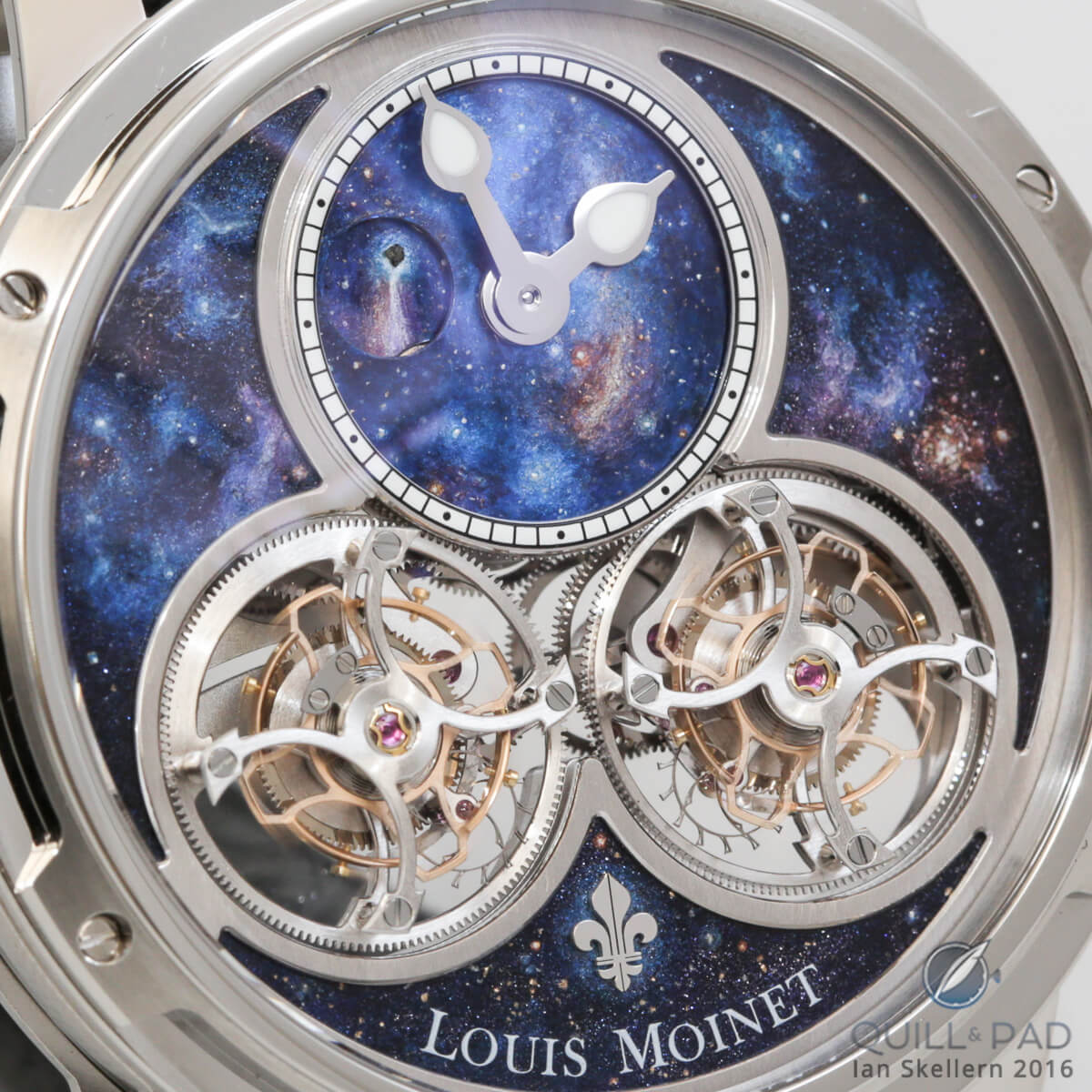
Louis Moinet Sideralis (not the Evo model in the GPHG competition)
GG: The Louis Moinet seems like a technical tour de force, and in videos the spinning disks are a delight to the eye, but I’m left wondering to what end all of the fireworks are devoted. Unless I am sorely mistaken the “sidereal” display doesn’t actually have anything to do with telling sidereal time, and the claim that this is the world’s first watch in which a double tourbillon powers a complication seems pretty thin gruel indeed to me too, Ian.
RS: The Louis Moinet Sideralis Evo is beautiful and a wonderful expression of astronomical whimsy. The two giant tourbillons rotating in opposite directions to one another, the complex balance wheels, and the elevated carriages utterly demand your attention.
My first thought when I saw the watch and its name was that it might feature a sidereal and mean solar regulator, delivering some sort of astronomical complication to the wearer. I won’t say I was disappointed to find out otherwise, but the Sideralis is certainly something more poetic. The carriages are toothed and they drive the two-layered dial at 12 o’clock.
Yes, that’s right; these two tourbillons actually power an additional complication. As a result the dial is a constant moving image, briefly showing one of the three heavenly bodies that sit on the lower dial, under the aperture. I really like it and I want to believe that the Sideralis will do well this year, but I think there is some serious competition doing more serious stuff with their tourbillons.
MG: Louis Moinet has created a visually balanced watch with two huge tourbillons that seem to float in the air, topped off with unique complication that is actually powered by both tourbillons! This complication not only shows three heavenly bodies, but is even made from fragments of it. This is fun and functionality in one watch.
For more information, please visit http://louismoinet.com/collection-sideralis-p62.php.
Quick Facts Louis Moinet Sideralis Evo
Case: 47.4 mm, white gold
Movement: manually wound caliber with one-minute double tourbillon; 72-hour power reserve
Functions: hours, minutes; rotating dial disk driven by tourbillons
Limitation: 12 pieces
Price: 255,000 Swiss francs
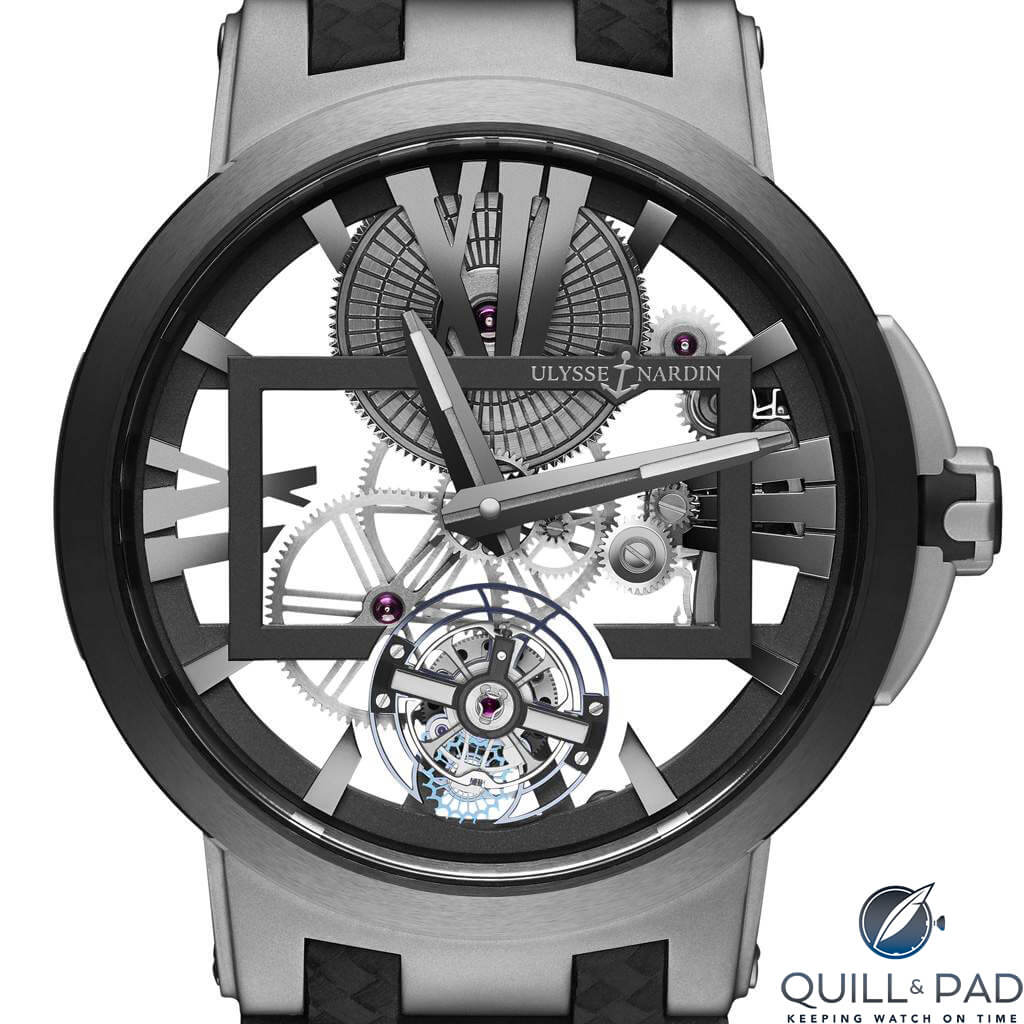
Ulysse Nardin Executive Skeleton Tourbillon
Ulysse Nardin Executive Skeleton Tourbillon
IS: I’m a big fan of being able to see as much of the movement as possible and the Ulysse Nardin Executive Skeleton Tourbillon amply satiates my micro-engineering fix. The titanium case and skeletonized movement make for a very light and comfortably-wearing watch and I like the way that the eye is drawn down into the movement.
But the base caliber was launched back in 2013 (see 5 In-House Calibers From Ulysse Nardin), and this variation just isn’t different enough for the Executive Skeleton Tourbillon to have a shot at first place in this hard-fought category.

Ulysse Nardin Executive Skeleton Tourbillon
GG: I had a chance to handle the Ulysse Nardin in Basel earlier this year and liked it a lot; and as a one-time owner of one of UN’s Executive line of watches, I’m a fan of the design cues, including the large Roman numerals and bold ceramic bezel, as well.
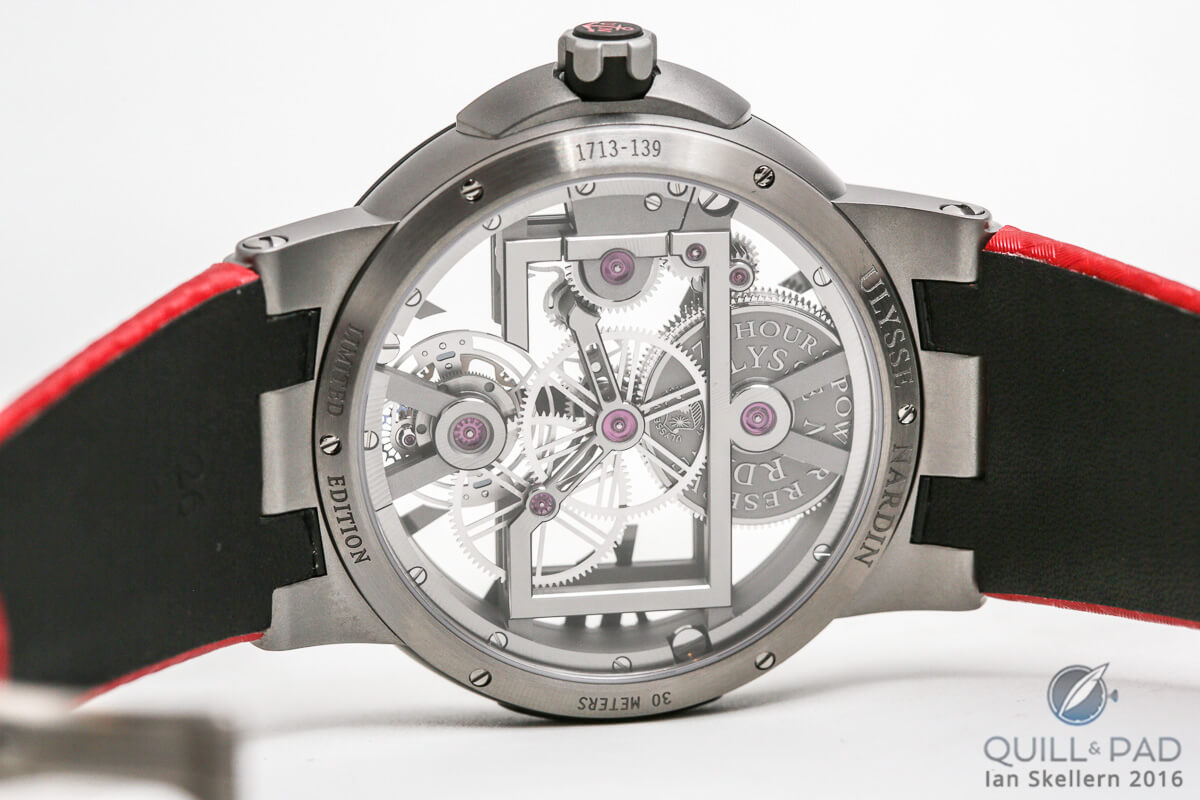
View from the back of the Ulysse Nardin Executive Skeleton Tourbillon
This watch isn’t a technical slouch, either, with its silicon tourbillon. And at between one-quarter and one-sixth the retail price of the other pre-selections in this category it seems almost as if they’re giving it away!
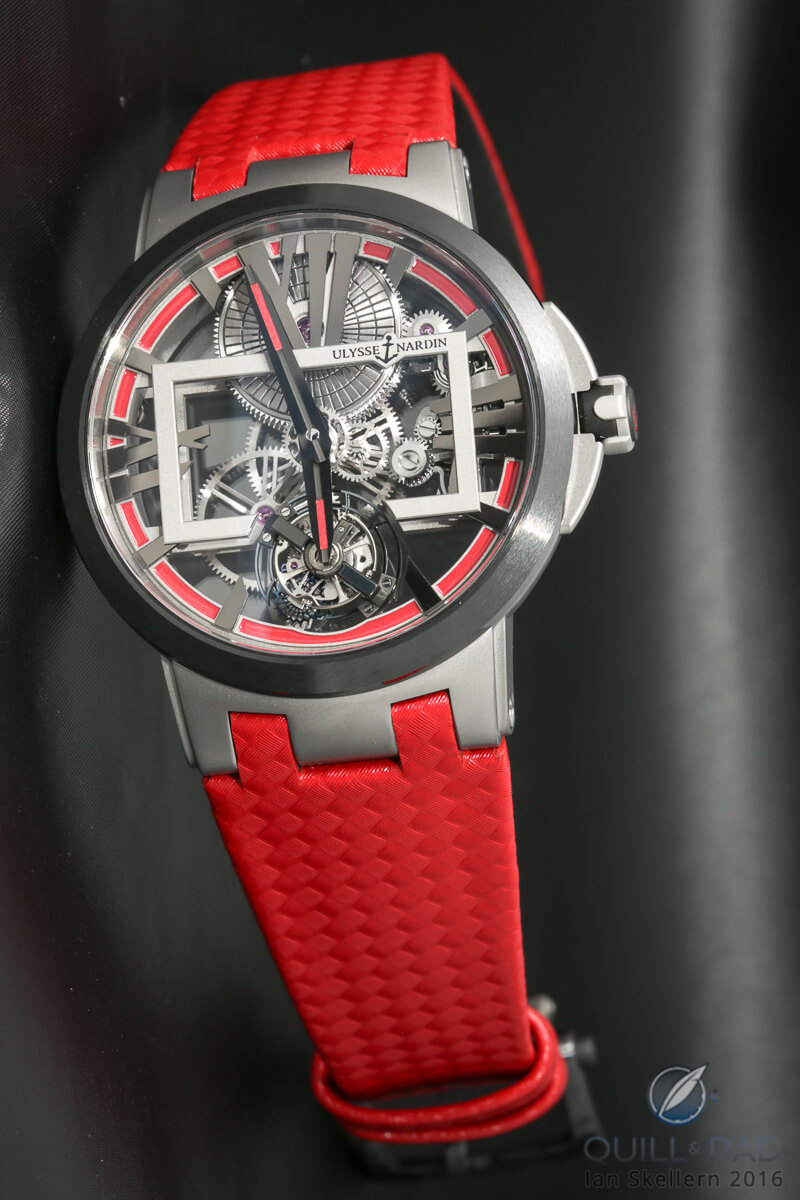
Ulysse Nardin Executive Skeleton Tourbillon
For more information, please visit www.ulysse-nardin.com/product/executive-skeleton-tourbillon-1713-139.
Quick Facts Ulysse Nardin Executive Skeleton Tourbillon
Case: 45 x 12.4 mm, titanium
Movement: manually wound Caliber UN-170 Manufacture with balance spring and escape wheel in silicon; 170-hour power reserve and one-minute tourbillon
Functions: hours, minutes
Price: 38,000 Swiss francs
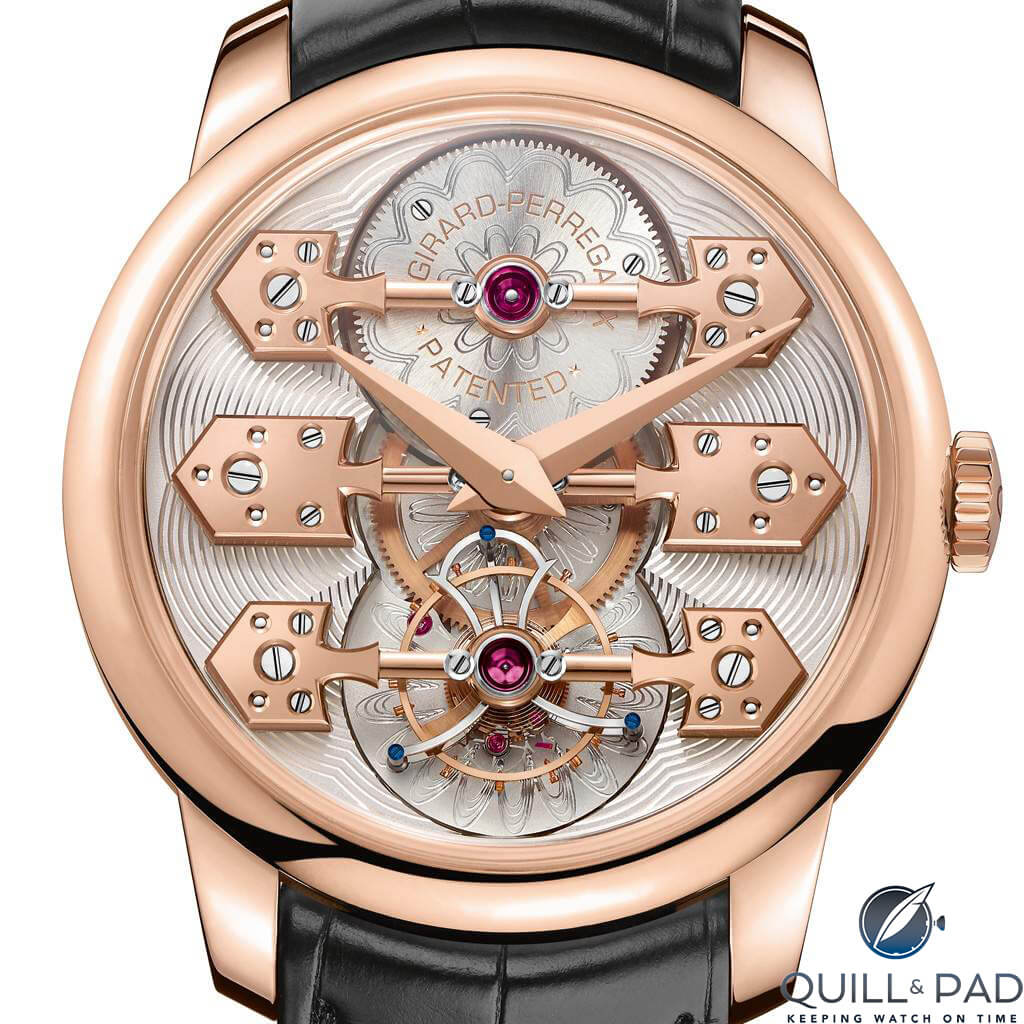
Girard-Perregaux La Esmeralda Tourbillon
Girard-Perregaux La Esmeralda Tourbillon
IS: The list of classic tourbillons – those that have well and truly stood the test of time – is a very short one. It may be short, but it is one that certainly includes the Girard-Perregaux Three Gold Bridges tourbillon. This is a model that has been around for so long that it would be easy for me to dismiss it as yet another “great tourbillon” in this category, but nothing much more than we have seen before over the last decade. However, that would be wrong.
The La Esmeralda Tourbillon is based on Caliber GP09400, which was launched in 2014. It is notable − in addition to those iconic gold bridges − for its micro rotor, which allows for a larger diameter mainspring barrel offering a 60-hour power reserve, up from the pre-micro-rotor power reserve of 48 hours.
I can’t remember ever seeing a Girard-Perregaux Three Gold Bridges that I didn’t like, and La Esmeralda is no exception.
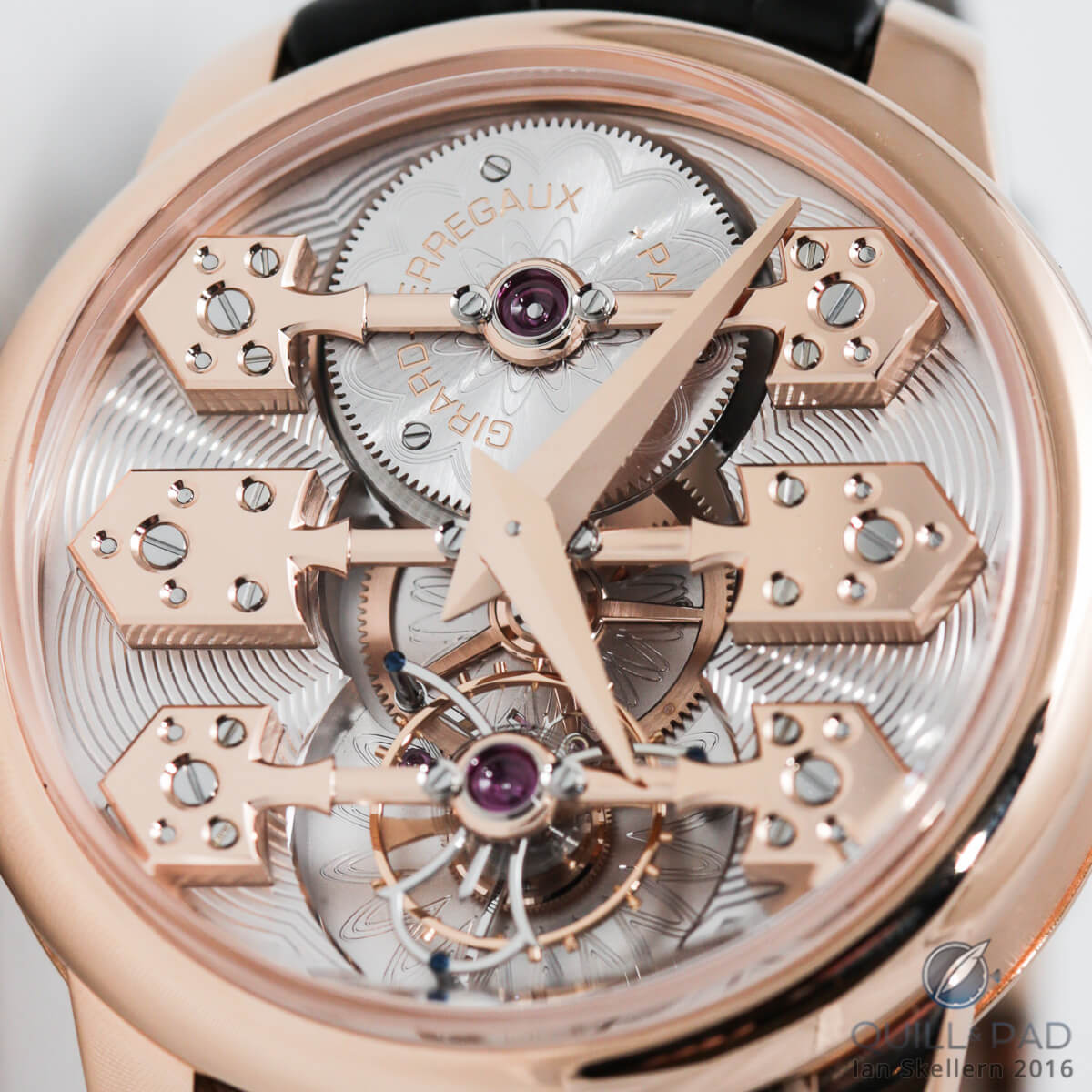
A close look at the dial side of the Girard-Perregaux La Esmeralda Tourbillon
AG: On the exact opposite of the spectrum from De Bethune, Girard-Perregaux is continuing to develop its iconic tourbillon with three golden bridges. Technically, this is quite interesting as the whole movement is held together by these bridges, which are aesthetically a bold declaration. I also find the brand did a pretty good job with the guillloche and the elegant case.

View through the display back of the Girard-Perregaux La Esmeralda Tourbillon: where is that stealthy micro rotor?
RS: The classic but bold style of this watch is beautifully executed. The three gold bridges are iconic symbols of the brand and provide a wonderful template upon which to deliver a two-handed watch with dial-side tourbillon.
If you prefer your tourbillons to keep their feet grounded in the age that they were borne out of, the Esmeralda is extremely appealing. It is “just” a tourbillon, though, and today there are at least another 50 brands that can build something of equivalent complexity.
I love this watch, but I need to be cruel to land on my winner, so the Esmeralda just misses the cut. I am surprised that so little imagery and detail has been communicated about the back of the movement, because the GP09400 employs an automatic micro rotor of such stealth that it makes a regular micro rotor or even a peripheral rotor look positively kitsch.
The rotor sits beneath the spring barrel, which stands proud at 12 o’clock on the dial, and behind the large plate that occupies the case back. Without shaking the thing, you would be forgiven for swearing that it was a manually wound caliber.
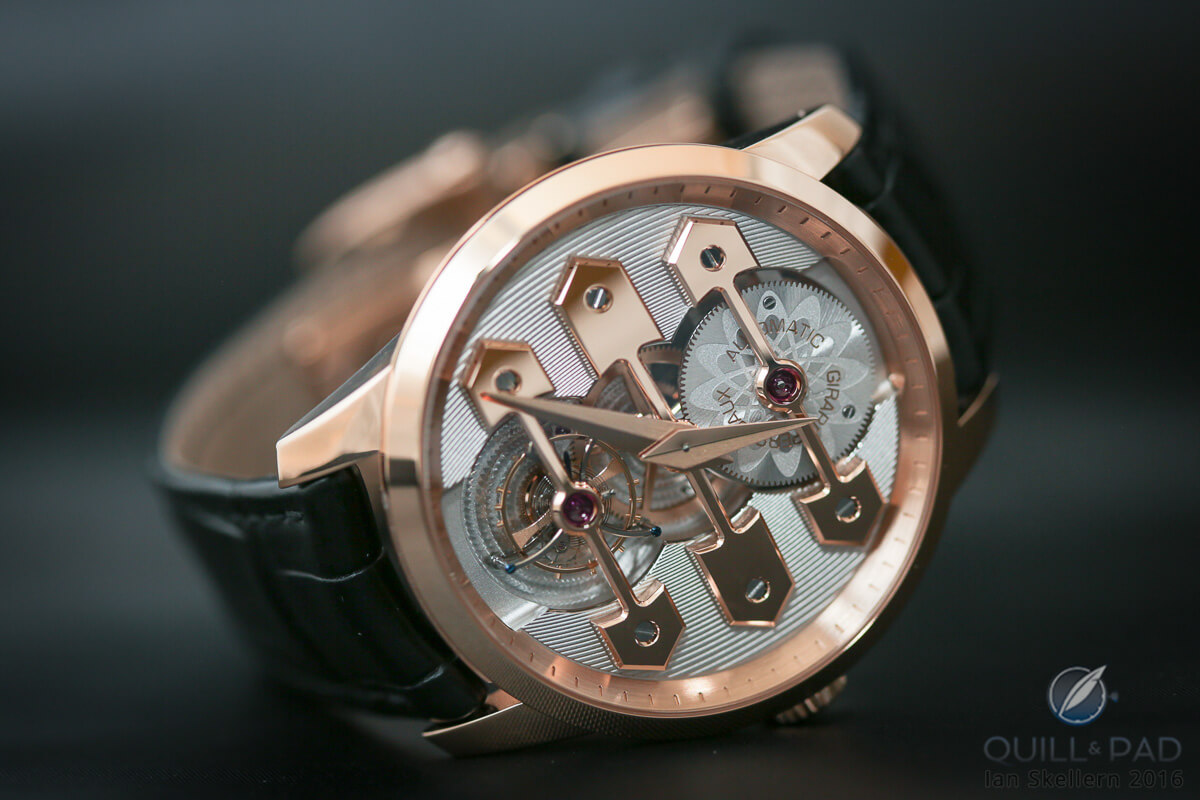
Girard-Perregaux La Esmeralda Tourbillon
GG: What’s wrong with the Girard-Perregaux Esmeralda? Absolutely nothing! I also saw this piece at Baselworld and liked it quite a bit, but for me its good looks and links to Girard-Perregaux’s history weren’t quite enough to lift it into my top three.
For more information, please visit www.gphg.org/horlogerie/en/watches/la-esmeralda-tourbillon.
Quick Facts Girard-Perregaux La Esmeralda Tourbillon
Case: 43.7 x 14.55 mm, pink gold
Movement: automatic Caliber GP09400 with micro rotor and one-minute tourbillon with screw balance
Functions: hours, minutes
Price: 194,000 Swiss francs

Bovet 1822 Ottantasei Flying Tourbillon
Bovet 1822 Ottantasei Flying Tourbillon
IS: The Bovet 1822 Ottantasei Flying Tourbillon is my clear winner in the tourbillon category because it is not only a superlative tourbillon wristwatch, it’s also a completely new watch for 2016: new design codes; new case; new movement.
And not that it means better or worse, but the fact that the Ottantasei Flying Tourbillon is designed by Pininfarina and developed and manufactured in-house by Bovet is the icing on the cake for me.
The brief to Pininfarina was “lightness,” and the Ottantasei Flying Tourbillon is light both visually and physically. Physically because it is made from titanium and is quite thin, visually because there is more sapphire crystal in the case than metal.
An impressive ten-day power reserve, innovative winding system requiring less turns, and I particularly like the fact that all of the engineering and mechanisms are visible while still providing a very legible time display. . . and that’s easier said than done. The Ottantasei Flying Tourbillon is a hands-down winner for me.
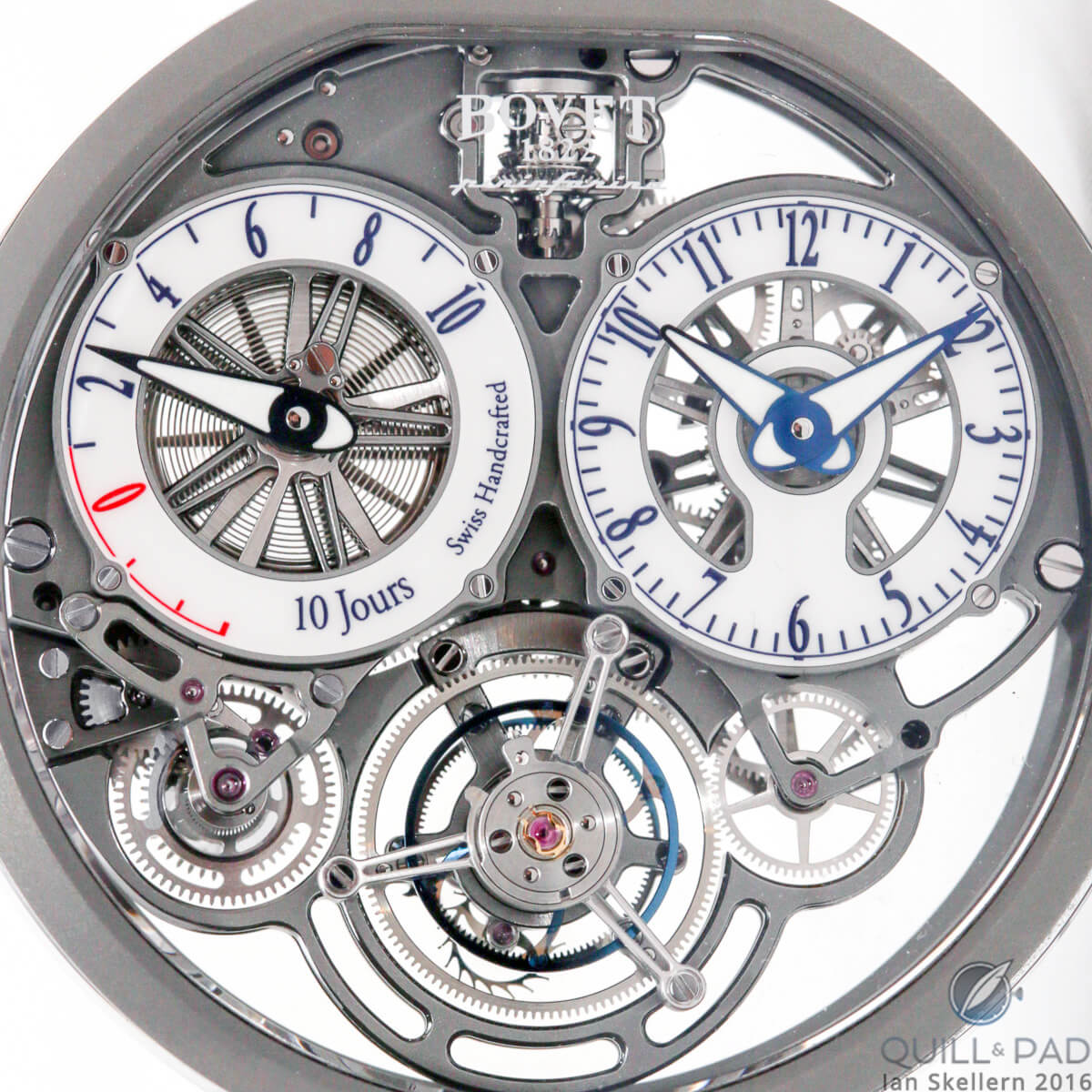
Dial side of the Bovet OttantaSei by Pininfarina
RS: The Bovet Ottantasei Flying Tourbillon is really cool looking and the ten days of autonomy is impressive. I also like the balance wheel, the exposed power reserve indicator mechanism, and the overall balance of this watch. I can’t really fault it; I just don’t think it will take home the crown, Ian.
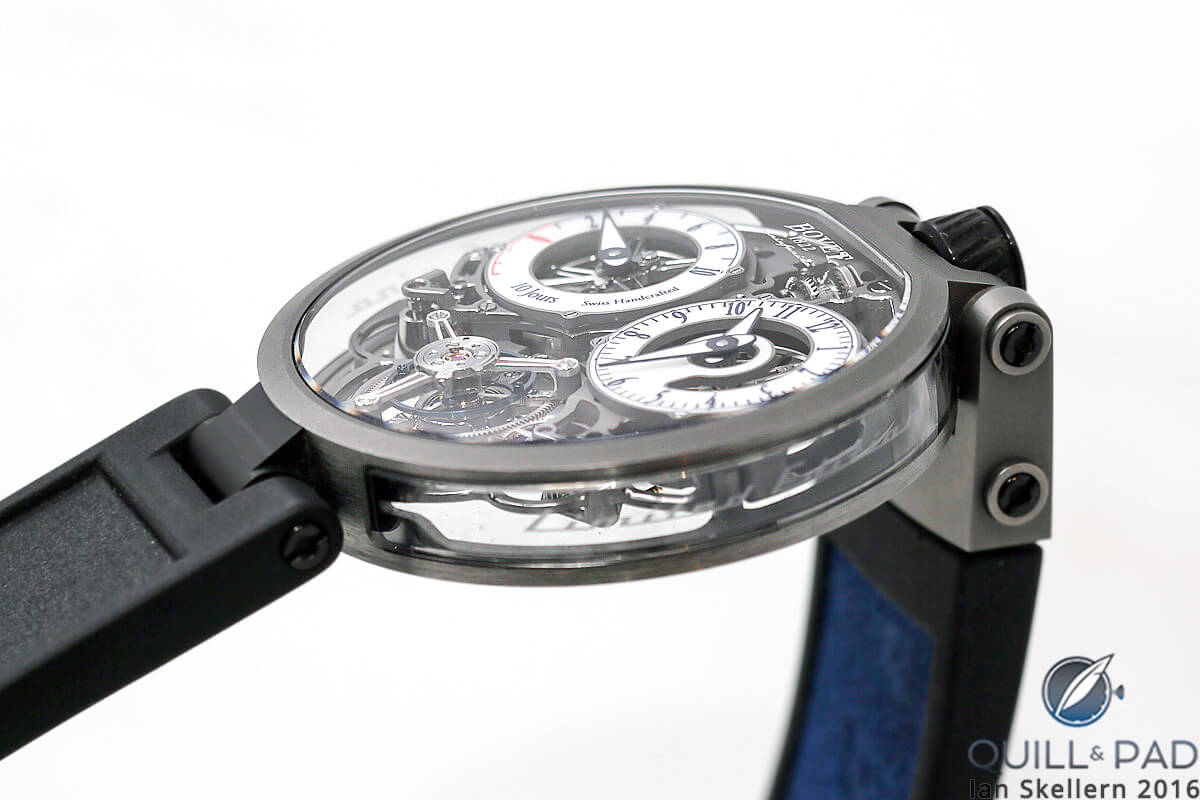
Bovet OttantaSei by Pininfarina
GG: As a rule I’m not a big fan of Bovet’s normally ornate house style, but this design collaboration with Pininfarina is much more up my alley, and its relative simplicity allows me to focus on this piece’s technical features that include a ten-day power reserve, spherical winding differential, and flying tourbillon. At 44 mm in diameter and 12 mm in height it isn’t so huge as to be unwearable, and its feathery lightness at just less than 67 grams including the strap is impressive as well.
JM: The winner for this category was difficult to choose but I based my decision on mechanical execution combined with style.
My style preference tends toward the realm of industrial complexity, where the Ottantasei Flying Tourbillon fits perfectly with that aesthetic. The movement is on full display, not just because it is skeletonized, but because the entire case – front, back, and sides – is made of sapphire crystal to allow viewing the movement from every possible angle.
The case shape is tough and mechanical while providing a perfect home for the incredible and delicate mechanics within. The movement design by Bovet is always impressive, and the tourbillons always seem impossibly thin. The spherical differential winding mechanism is awesome, and the 11.5 days of total power reserve means you get to enjoy this watch for longer than most before having to wind again.
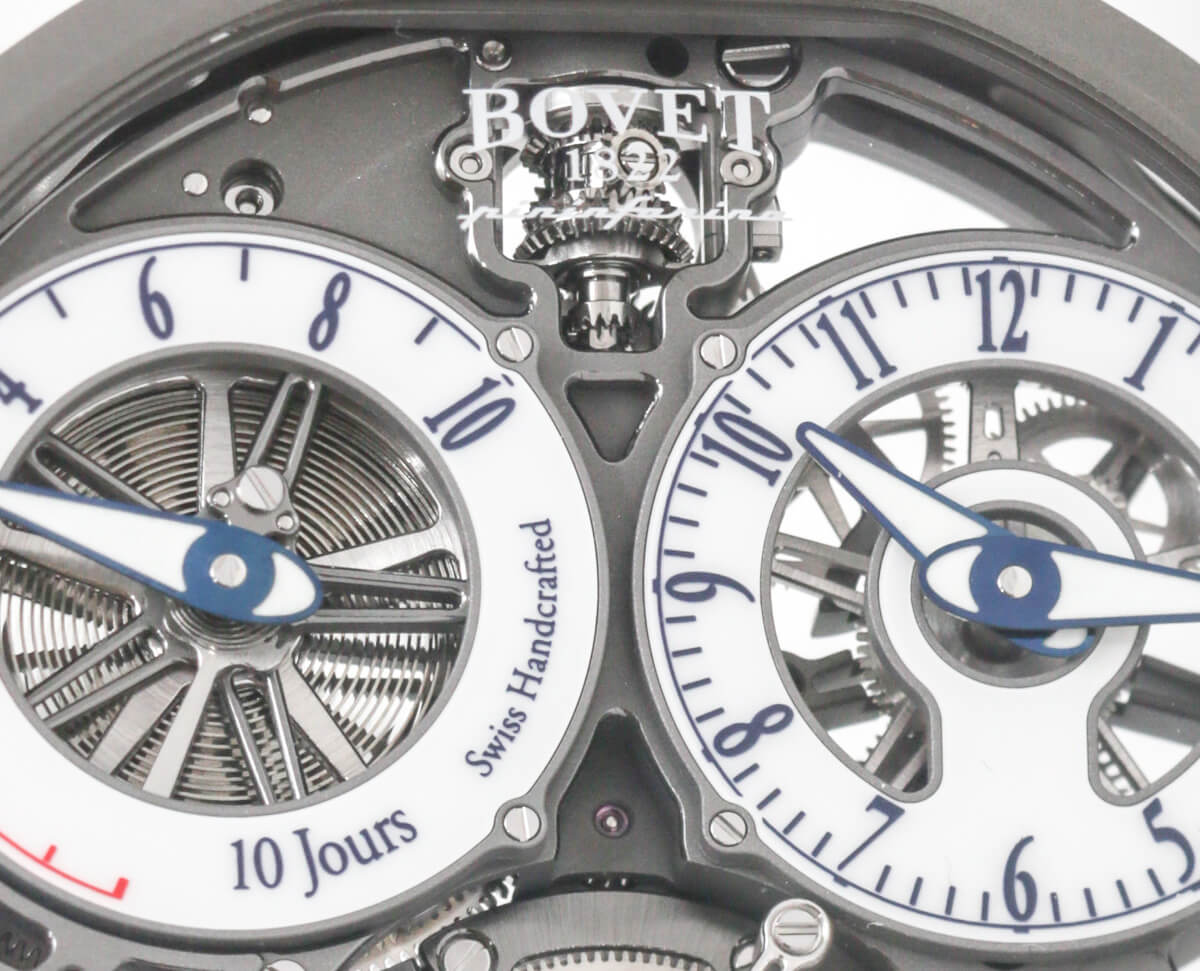
The spherical winding system of the Bovet Ottantasei is visible behind the brand’s logo at the top
The reason I love tourbillons is more because of the mechanics involved and less because of any chronometric benefit, so for me the Bovet 1822 Ottantasei Flying Tourbillon comes out on top as the most fantastical mechanical creation to stare at on your wrist!
Further reading: Transparently Sublime Bovet Ottantasei By Pininfarina: Near Perfection, Bar One Tiny “Flaw.”
Quick Facts Bovet 1822 Ottantasei Flying Tourbillon
Case: 44 x 12 mm, titanium, sapphire crystal display back and two case band windows, water resistance 30 meters
Dials: available in either white lacquer or brushed blue
Movement: manually wound Caliber 17BM03 with 10-day power reserve; patented spherical differential winding system, 2.5 Hz balance, patented flying one-minute tourbillon
Functions: hours, minutes; power reserve indicator
Limitation: 86 pieces
Guarantee: 5 years
Price: 165,000 Swiss francs (excluding taxes)
Predicted Winners
Ian: Bovet 1822 Ottantasei Flying Tourbillon
GaryG: Bovet 1822 Ottantasei Flying Tourbillon
Joshua: Bovet 1822 Ottantasei Flying Tourbillon
Alex: De Bethune Kind of Blue DB28T Tourbillon
Martin: De Bethune Kind of Blue DB28T Tourbillon
Ryan: Rudis Sylva RS 16 Harmonious Oscillator
And the winner of best Tourbillon watch at the 2016 GPHG went to the Girard-Perregaux La Esmeralda Tourbillon.
For more of our predictions in the 2016 Grand Prix d’Horlogerie de Genève (GPHG), please see:
Ladies Category
Ladies’ High-Mech Category
Artistic Crafts Category
Jewellery Category
Calendar Category
Travel Time Category
Mechanical Exception Category
Petite Aiguille
Aiguille d’Or

Trackbacks & Pingbacks
[…] more of our predictions in the 2016 GPHG, please see: Men’s Category Tourbillon Category Ladies Category Ladies’ High-Mech Category Artistic Crafts Category Chronograph Category […]
[…] in the 2016 Grand Prix d’Horlogerie de Genève (GPHG), please see: Men’s Category Tourbillon Category Ladies Category Ladies’ High-Mech Category Artistic Crafts Category Chronograph Category […]
[…] more of our predictions in the 2016 Grand Prix d’Horlogerie de Genève (GPHG), please see: Tourbillon Category Chronograph Category Sport Category Calendar Category Travel Time Category Mechanical Exception […]
[…] more of our predictions in the 2016 Grand Prix d’Horlogerie de Genève (GPHG), please see: Tourbillon Category Ladies’ High-Mech Category Artistic Crafts Category Jewellery […]
[…] more of our predictions in the 2016 Grand Prix d’Horlogerie de Genève (GPHG), please see: Ladies Category Ladies’ High-Mech Category Artistic Crafts Category Jewellery Category Calendar Category Travel […]
[…] more of our predictions in the 2016 Grand Prix d’Horlogerie de Genève (GPHG), please see: Predictions For The Men’s Category Predictions In The Tourbillon Category Predictions For The Ladies Category Predictions In The Ladies’ High-Mech Category Predictions […]
[…] One Tiny “Flaw”), which I picked as this year’s winner of the Tourbillon Category (see Predictions In The Tourbillon Category Of The 2016 Grand Prix d’Horlogerie de Genève). But the Ottantasei wasn’t at all ornate, in fact it was the antithesis of ornate and […]
[…] more of our predictions for the 2016 Grand Prix d’Horlogerie de Geneve (GPHG), please see: Predictions For The Men’s Category Predictions In The Tourbillon Category Predictions For The Ladies Category Predictions In The Ladies’ High-Mech Category Predictions […]
[…] more of our predictions for the 2016 Grand Prix d’Horlogerie de Geneve, please see: Predictions For The Men’s Category Predictions In The Tourbillon Category Predictions For The Ladies Category Predictions In The Ladies’ High-Mech Category Predictions […]
Leave a Reply
Want to join the discussion?Feel free to contribute!